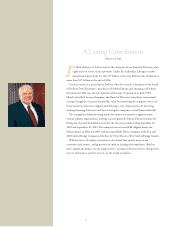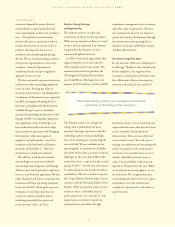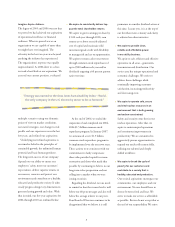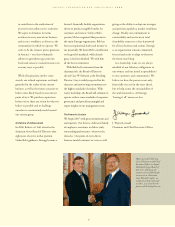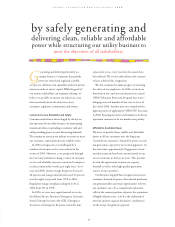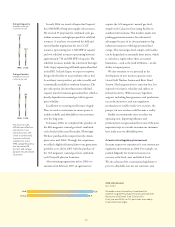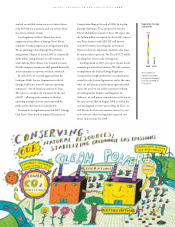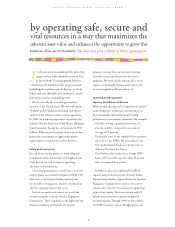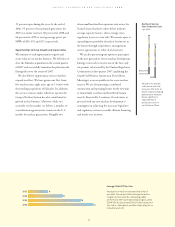Entergy 2006 Annual Report Download - page 18
Download and view the complete annual report
Please find page 18 of the 2006 Entergy annual report below. You can navigate through the pages in the report by either clicking on the pages listed below, or by using the keyword search tool below to find specific information within the annual report.
16
2006 CO2Emissions
tons, millions
We made a second voluntary commitment to
stabilize our greenhouse gas emissions at 20 percent
below year 2000 levels from 2006 to 2010.
As of year-end 2006, our CO2emissions were nearly
10 percent below target.
In early 2006, we issued a Request for Proposal
for 2,000 MW of long-term supply-side resources.
We received 35 proposals for combined-cycle gas
turbine resources and eight proposals for solid fuel
resources. A year later, we narrowed the field and
entered further negotiations for two CCGT
resources representing over 1,300 MW of capacity
and two solid fuel resources representing between
approximately 730 and 880 MW of capacity. The
solid fuel resources include the selection of Entergy’s
Little Gypsy repowering self-build option identified
in the RFP. At Little Gypsy, we expect to repower
this gas-fired facility to use petroleum coke as fuel.
As a refinery waste product, pet-coke is readily and
economically available in southern Louisiana. The
pet-coke option also introduces more solid fuel
capacity into the Louisiana generation fleet, which is
heavily dependent on natural gas with its greater
price volatility.
In addition to executing our Resource Supply
Plan, we took several actions to ensure power is
readily available and affordable to our customers
over the long term.
In January 2006, we completed the purchase of
the 480-megawatt, natural gas-fired, combined-
cycle Attala facility near Kosciusko, Mississippi.
We have purchased the output from the Attala
plant since mid-2004. Through this acquisition,
we added a highly efficient plant to our generation
portfolio as we did in 2005 with the purchase of
the 718-megawatt, natural gas-fired, combined-
cycle Perryville plant in Louisiana.
After initiating negotiations in late 2006, we
announced in February 2007 an agreement to
acquire the 322-megawatt, natural gas-fired,
simple-cycle Calcasieu Generating Facility in
southwestern Louisiana. This modern, quick-start
peaking generation resource has substantial
advantages because of its close proximity to big
industrial customers with large potential load
swings. This natural gas-fired, simple-cycle facility
can be dispatched on extremely short notice, which
is critical in a region where there are natural
limitations – such as the Gulf of Mexico – on the
ability to import power.
We also continue to see potential in the
development of new nuclear capacity at our
Grand Gulf Nuclear Station and River Bend
Station. Nuclear generation is emission-free, less
exposed to fuel price volatility and subject to
federal incentives. With necessary legislative
support, including loan guarantee and production
tax credit incentives, and state regulatory
mechanisms to enable timely cost recovery, the
prospect of new nuclear could become a reality.
Finally, we continuously strive to reduce our
operating costs. Improving efficiency and
productivity in our generation fleet is one of the most
important steps we can take to ensure our customers
have ready access to affordable power.
A Constructive Regulatory Environment
In many respects we experienced a very constructive
regulatory environment in 2006. For example, we
pushed diligently for storm restoration cost
recovery at the local, state and federal levels.
We also advocated for securitization legislation to
preserve affordable rates for our customers and
We aspire to safe,
efficient and effective
operations in our
utility business.We
strive to continually
improve customer
satisfaction. Since
1998, outage frequency
has decreased 48
percent and outage
duration has decreased
32 percent.
Outage Frequency
average number per
customer per year
3.54
1.83
1998 2006
Outage Duration
average minutes per
customer per year
278
189
1998 2006
42.6
38.9
Goal
Actual


